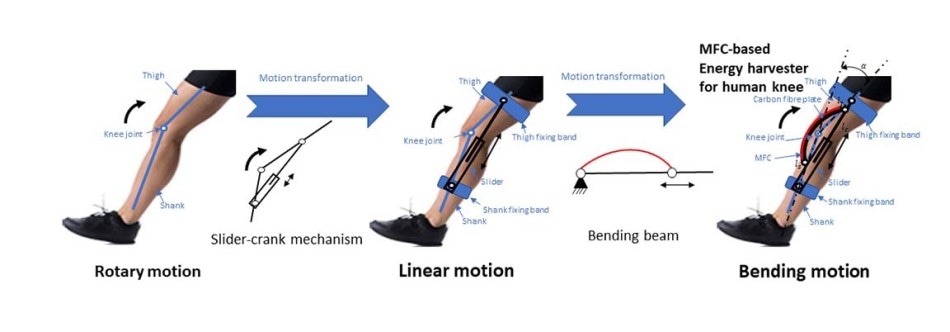Jul 18 2019
Just think about powering the devices by walking. This possibility might not be away from reality with the recent technology created by a team of scientists at the Chinese University of Hong Kong.
 Diagram of the slider-crank mechanism that generates energy during the knee’s motion. (Image credit: Gao et al.)
Diagram of the slider-crank mechanism that generates energy during the knee’s motion. (Image credit: Gao et al.)
The team reports the technology in Applied Physics Letters, from AIP Publishing. An energy harvester is mounted to the wearer’s knee and can produce 1.6 mW of power while the wearer walks without any additional effort. The energy is adequate to power small electronics such as GPS devices and health monitoring equipment.
Self-powered GPS devices will attract the attention of climbers and mountaineers.
Wei-Hsin Liao, Study Author and Professor, Department of Mechanical and Automation Engineering, Chinese University of Hong Kong
The scientists employed a unique smart macrofiber material, which produces energy from any kind of bending it undergoes, to form a slider-crank mechanism—equivalent to what powers a motor. The authors decided to fasten the device to the knee owing to the knee joint’s wide range of motion, in comparison with most other human joints.
“These harvesters can harvest energy directly from large deformations,” stated Liao.
The constant back-and-forth motion experienced by the material when the wearer walks, and whenever the knee flexes, makes the device to bend and produce electricity. This implies the harvester can “capture biomechanical energy through the natural motion of the human knee,” states Liao.
Earlier models of wearable energy harvesters exploited the vibration produced in the device due to the motion, which accompanies limitations concerning efficiency.
“The frequency of human walking is quite slow, which significantly decreases the energy-harvesting capability,” Liao stated. Since the team’s device employs a different technique, it overcomes this disadvantage.
The prototype has a weight of just 307 g (0.68 pounds) and was tested on human subjects walking at speeds from 2 to 6.5 km per hour (about 1 to 4 miles per hour). The scientists compared the wearers’ breathing patterns with and without the device and found out that the energy needed to walk remained unchanged, implying that the device is producing power at no cost to the human.
The scientists record the benefits of an efficient, wearable energy harvester and focus on future commercialization of the technology.
Self-powered equipment can enable users to get rid of the inconvenient daily charge. This energy harvester would promote the development of self-powered wearable devices.
Wei-Hsin Liao, Study Author and Professor, Department of Mechanical and Automation Engineering, Chinese University of Hong Kong